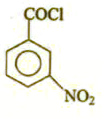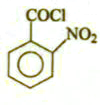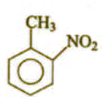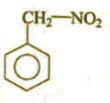The molecular formula of a commercial resin used for exchanging ions in water softening is C8H7SO3Na(mol.wt.206) . What would be the maximum uptake of Ca2+ ions by the resin when expressed in mole per gram resin?
1206
2309
1412
1103
The correct Answer is:C
To solve the problem of determining the maximum uptake of Ca2+ ions by the resin C8H7SO3Na, we will follow these steps:
Step 1: Understand the Molecular Weight
The molecular weight of the resin C8H7SO3Na is given as 206 g/mol. This means that 1 mole of this resin weighs 206 grams.
Step 2: Calculate Moles of Resin per Gram
To find out how many moles of resin are present in 1 gram, we can use the formula:
Moles of resin=1 gramMolar mass of resin (g/mol)
Substituting the values:
Moles of resin=1 gram206 g/mol=1206 moles
Step 3: Understand the Ion Exchange Reaction
In the ion exchange process, Na+ ions in the resin are exchanged for Ca2+ ions from hard water. The stoichiometry of the reaction indicates that:
2Na++Ca2+→C8H7SO3Ca+2Na+
This means that 2 moles of Na+ are exchanged for 1 mole of Ca2+.
Step 4: Calculate Moles of Ca2+ per Mole of Resin
From the stoichiometry, we can deduce that:
2 moles of resin→1 mole of Ca2+
Thus, for 1 mole of resin:
Moles of Ca2+=12 moles
Step 5: Calculate Moles of Ca2+ per Gram of Resin
Now, we can find the moles of Ca2+ that can be exchanged for the amount of resin we calculated earlier:
Moles of Ca2+=(1206 moles of resin)×(12 moles of Ca2+ per mole of resin)
Calculating this gives:
Moles of Ca2+=1206×12=1412 moles
Final Answer
Thus, the maximum uptake of Ca2+ ions by the resin when expressed in moles per gram of resin is:
1412 moles of Ca2+ per gram of resin
---
The molecular weight of the resin C8H7SO3Na is given as 206 g/mol. This means that 1 mole of this resin weighs 206 grams.
To find out how many moles of resin are present in 1 gram, we can use the formula:
Moles of resin=1 gramMolar mass of resin (g/mol)
Substituting the values:
Moles of resin=1 gram206 g/mol=1206 moles
In the ion exchange process, Na+ ions in the resin are exchanged for Ca2+ ions from hard water. The stoichiometry of the reaction indicates that:
2Na++Ca2+→C8H7SO3Ca+2Na+
This means that 2 moles of Na+ are exchanged for 1 mole of Ca2+.
From the stoichiometry, we can deduce that:
2 moles of resin→1 mole of Ca2+
Thus, for 1 mole of resin:
Moles of Ca2+=12 moles
Now, we can find the moles of Ca2+ that can be exchanged for the amount of resin we calculated earlier:
Moles of Ca2+=(1206 moles of resin)×(12 moles of Ca2+ per mole of resin)
Calculating this gives:
Moles of Ca2+=1206×12=1412 moles
Thus, the maximum uptake of Ca2+ ions by the resin when expressed in moles per gram of resin is:
1412 moles of Ca2+ per gram of resin
Topper's Solved these Questions
Similar Questions
The chemical formula of the chelating agent Versence is C2H4N2(C2H2O2Na) If each mol of this compound could bind 1 mol of Ca2+, what would be the rating of pure Versene, expressed as mgCaCO3 bound per g. Of chealting agent? Ca2+ is expressed in terms in terms of amount of CaCO3 it could form.
[Mwof vesene=380,MwofCaCO3=100gmol−1]View SolutionRH2 (ion exchange resin) can replace Ca2+ ions in hard water as RH2+Ca2+→RCa+2H+. If L of hard water after passing through RH2 has pH=3 then hardness in parts per million of Ca2+ is :
View Solution
Knowledge Check
- Question 1 - Select One
The amount of energy when million atoms of iodine are completely converted into I− ions in the vapour state according to the equation,I(g)+e−toI−_((g)) is 4.9X10−13 J.What would be the electron gain enthalpy of iodine in terms of KJ mol−1 and eV per atom? (A)295 , 3.06 (B)− 295, − 3.06 (C)439 , 5.09 (D)− 356 , − 7.08
A295,3.06B−295−3.06C439,5.09D−356,−7.08 - Question 2 - Select One
Compound A having molecular formula C7H7NO2 can undergo reduction with Sn + HCl. Treatment of A with KMnO4 gives a compound B (C7H5NO4) which has lower boiling point compared to its other isomer, B when treated with SOCl2 produces C.C when treated with CH2N2 produces D of molecular formula C8H5N3O3 . D when treated with Ag/H2O produces E.
Find out structure of C:A B
B C
C D
D
- Question 3 - Select One
Compound A having molecular formula C7H7NO2 can undergo reduction with Sn + HCl. Treatment of A with KMnO4 gives a compound B (C7H5NO4) which has lower boiling point compared to its other isomer, B when treated with SOCl2 produces C.C when treated with CH2N2 produces D of molecular formula C8H5N3O3 . D when treated with Ag/H2O produces E.
Find out structure of A:A B
B C
C D
D
Name the phenol with molecular formula C7H8O which on treatment with Br2 water readily gives a precipitate of C7H5OBr3.
View SolutionIn photosynthesis, 6 molecules of carbon combine with an equal number of water molecules through a complex series of reactions to give a molecule of glucose having a molecular formula C6H12O6. How many grams of water would be requried to produce 18g of glucose? Compute the volume of water so consumed assuming the density of water to be 1gcm−3.
View SolutionA mixture of ferric oxide (Fe2O3) and Al is used as a solid rocket fuel which reacts to give Al2O3 and Fe . No other reactants and products are involved . On complete reaction of 1 mole of Fe2O3, 200 units of energy is released.
(a) Write a balance reaction representing the above change.
(b) What should be the ratio of masses of Fe2O3 and Al taken so that maximum energy per unit of fuel is released.
(c) What would be energy released if 16 kg of Fe2O3 reacts with 2.7 kg of Al.View SolutionA sample of hard water is found to contain 40 mg of Ca2+ ions per litre. The amount of washing shoda (Na2CO3) required to soften 5⋅0L of the sample would be
View SolutionCompound A having molecular formula C7H7NO2 can undergo reduction with Sn + HCl. Treatment of A with KMnO4 gives a compound B (C7H5NO4) which has lower boiling point compared to its other isomer, B when treated with SOCl2 produces C.C when treated with CH2N2 produces D of molecular formula C8H5N3O3 . D when treated with Ag/H2O produces E.
Find out structure of E :View Solution

